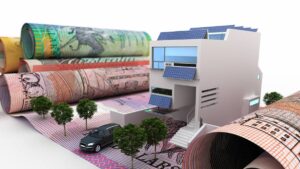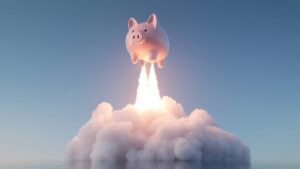Aussie Property: RBA on hold for now, but if you’re in debt up to the eyeballs it’s time to learn to swim

Via Getty
The Reserve Bank of Australia held the official cash rate at 4.1% this week, but looks ready to pull the trigger for a rate hike in August, with RBA chair Dr P. Lowe citing ongoing concerns around the stickiness of inflation, Australia’s tight labour markets and uncertainty relating to the household sector.
In staying mum on the OCR at 4.1%, the RBA noted that:
1) interest rates have already been increased by 4%;
2) higher rates are working to establish a “more sustainable balance between supply and demand” which is a positive sign we are getting close to the top;
3) pausing provides time for the bank to better assess the outlook
This is a familiar policy pattern – it’s exactly what the RBA did and said back in April after holding rates steady, only to get back hiking again in May.
So – as was the case after the April pause – the bank’s retained guidance that “some further tightening of monetary policy [ie rate hikes] may be required to ensure that inflation returns to target in a reasonable timeframe”.
Lowe et al reiterated that this depended on “how the economy and inflation evolve”.
It also noted that it will continue to look closely at the global economy, household spending, inflation and the labour market.
This is what Dr Shane Oliver chief economist and head of investment strategy at AMP had to say on what happens next:
But reflecting the RBA’s hawkish guidance we are inclined to regard the decision to pause this month as just that rather than an indication that rates have peaked and we continue to allow for another two more 0.25% rate hikes, the next in August and then another in September ultimately taking the cash rate to a peak of 4.6%.
The pause in rate hikes comes after the biggest interest rate hiking cycle (of 400 basis points over 14 months) since the late 1980s, according to data compiled by AMP.
“While rates went up more in 1988-89, things were very different back then as household debt to income ratios were about one third of current levels and inflation expectations were much higher so it took more to slow the economy down, although at the time the RBA still went too far and tipped the economy into recession,” AMP’s Shane Oliver noted.

A speech by RBA Governor Lowe on 12th July will no doubt shed more light on the RBA’s views.
Until then the June quarter inflation outcome, to be released late this month, will be critical in determining whether there are more rate hikes ahead, according to CoreLogic research director, Tim Lawless.
Renewed growth in housing values is another factor weighing on RBA decisions.
While the RBA has been clear it doesn’t target asset prices, there’s clearly a risk higher house prices will add to the ‘higher inflation for longer’ scenario as homeowners feel wealthier and more willing to spend.
Despite rates holding firm in July, we could see some a further dampening of the recent exuberance seen across housing markets, where values have generally been rising since March, Lawless says.
CoreLogic’s Home Value Index for June showed a subtle easing in the rate of growth nationally, from 1.2% in May to 1.1% in June, which could be the first signs of some heat leaving the recovery trend.
“Currently high interest rates and the potential for a hike in August could weigh further on consumer sentiment, which is already around GFC lows,” Lawless says.
“Historically consumer sentiment and housing market sales have been closely correlated.”
However, while we say thanks for the breather after the the RBA hit the pause button this week, the damage done by the string of rate hikes since April last year mean that a variable rate borrower with a $600,000 mortgage will have seen $1300 a month added to their mortgage payments.
Looking at my fingers, that’s an extra $15,700 a year.
Even if the borrower is cleverer than most and has schnaffled 0.5% discount to their mortgage rate it would still mean an extra $13,300 on top of the usual – a veritable black hole for household spending intentions. Dr Oliver says many Australians on those fixed rates are now starting to experience that increase this quarter in one jump.
Paul Ryan, PropTrack senior economist, says while this is unlikely to be the peak in the cash rate, rates are close to their peak, which is good news for the housing market.
“So far, the housing market has shown remarkable resilience to sharply higher interest rates. Despite rates now at levels not seen since 2011, home prices increased further in June, and are up 2.3% over 2023 so far. Offsetting higher mortgage rates, strong buyer demand has been focused on a slower flow of new property listings and led to price increases.
“Forward indicators point to further home price growth in the months ahead. But continued higher interest rates remain a risk for the housing market. At some point, eroded borrowing capacities and weaker economic conditions brought about by higher interest rates may lead to price falls, as seen in 2022,” Ryan says.
Considering the pronounced lag in the flow through of rising rates, AMP says we’re potentially x2 more hikes for this cycle before the central bank hits the reverse button next year.
“While we are allowing for two more rate hikes taking the cash rate to a peak of 4.6% by around September, we anticipate that the RBA will have to reverse course next year and so we are allowing for four rate cuts in 2024 starting in February,” Dr Oliver says.
Credit where it’s not due
Housing activity could be further impacted if credit becomes less available, Lawless says.
“The average variable mortgage rate for new owner occupier loans is approximately 5.9%… With a three-percentage point serviceability buffer in place, new borrowers will be assessed to repay their loan at a mortgage rate close to 9%.
“The combination of high cost of living pressures, negative real income growth and the high cost of debt have made it hard for borrowers to obtain credit approval, especially with lenders less willing to lend on high debt-to-income ratios, high loan-to-income ratios or on smaller deposits.”
Lawless says that as more borrowers are exposed to higher interest rates, either via rising variable mortgage rates or the expiration of fixed rates, we are likely to see a progressive increase in mortgage arrears, albeit from record lows last year.
To date, the majority of borrowers have kept on track with their mortgage repayments.
APRA data for the March quarter suggests only half a per cent of home loan borrowers had fallen less than 90 days behind on their mortgage repayments.
While the portion of borrowers falling behind on their repayment schedule is likely to rise, Australia’s unemployment rate is forecast to remain below 5%, which should help to prevent a material blowout in mortgage arrears.
Double-dip time?
“Whether the current interest rate setting and the potential for a further hike in August is enough to push the housing market into a double-dip downturn remains uncertain.
“Despite the high interest rate environment, the housing sector is still facing an under supply which is likely to provide some support for values,” Lawless says.
CoreLogic data shows that the number of capital city homes advertised for sale is tracking about 26% below the previous five-year average and dwelling approvals continue to trend well below average levels. Low supply in the face of record net overseas migration and extremely tight rental conditions should be a key factor helping to offset the impact of higher interest rates.
CoreLogic March Qtr Property data
CoreLogic analysed approximately 76,000 dwelling resales last quarter, here’s the key takeaways:
-
The incidence of profit-making sales nationally declined to 92.3%, down from a recent high of 94.2% in the three months to May 2022
-
This marks the third consecutive quarter that profitability has declined
-
The rate of profit-making sales was highest in Hobart at 99%
-
Darwin had the highest rate of loss-making sales at 29.5% followed by Perth with 13.8%
-
The proportion of houses resold for a loss increased to 3.8% while the rate of loss-making unit resales increased to 15.4%
-
The median hold period for resales across Australia was 8.9 years in the March quarter, down from 9.9 years in the three months to December
-
The total nominal profit from resales in the March quarter is estimated to be $22.7 billion, down from $25.9 billion in the previous quarter, and down from a record high of almost $40 billion in the December quarter of 2021
-
The median nominal gain for resales was $276,500 nationally
Related Topics
UNLOCK INSIGHTS
Discover the untold stories of emerging ASX stocks.
Daily news and expert analysis, it's free to subscribe.
By proceeding, you confirm you understand that we handle personal information in accordance with our Privacy Policy.








